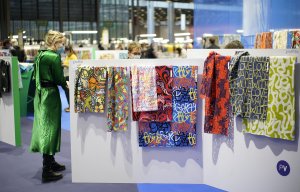
Fashion and sustainability white paper
Opinion


Janet Prescott on Premiere vision Paris, which took place from 16-18 September 2025.
9th October 2025
Janet Prescott
|
Paris
1000 plus exhibitors from 40 countries and seven major trading areas used Premiere Vision in Paris in September to show ideas for 2025-2026. They ranged from international companies and brand names to newcomers, and many specialists in technical developments.
Choices for autumn winter 2026/27 were pointedly geared to enable sustainability with offers of small quantities, circular systems and a dedicated area for deadstock.
The times they are a-changing
National groupings such as Textiles de France, and others from Portugal, Turkey, Italy, United Kingdom (UKFT), Korea and Japan were all seeking to combine many aspects of the business.
Knitwear fulfilled many criteria. This year PV saw a large number of Peru knitwear companies with China, Korea, Taiwan, Japan and some from the US. China made up the biggest contingent. Hong Kong was listed separately.
Italian and Turkish companies had a strong presence in all areas including, as in the UK and Italy, menswear fabrics. UKFT included iconic British names like Harris Tweed, Garigue, Luxury Fabrics, and this year Cats Bros, a trend-driven and fashion-focused studio, specialising in knit and surface-interest.
Visitors were looking to design developments with dependable sustainability in manufacturing which continues to be a major feature for the new season. Interestingly, some manufacturers state that they prefer 100% mono-material fabrics to improve recyclability in a circular economy. Buyers indicated that they have the option to choose alternative designs with eco-friendly features if needed.
Trad meets Generation Z
There was a distinct new feel about Premiere Vision this year with a different balance of countries showing. The resurgence of traditional fabrics and designs was mingled with new decorative elements, changing colours, shapes and appearance.
All due to developments in technology, making designs unique. For example, a growing enthusiasm for textile art draws on local traditions and hand embroideries, while folklore mixes with industrial techniques.
Social Media
The international fashion team at PV aims to identify and develop emerging ideas on trends before the start of the season.
This year, more video content was pointed at a young clientele on social media. Interviewers, including a fashion student, filmed in conversations with exhibitors and buyers on the stands, in noisy and effective snapshots
Knits for 2026/7
These include felted wools, and smooth calendered material, tightly knitted garments in traditional cold weather designs. The winter look also embraced thicker knits with wide ribs for the theme of comforting naturally sourced winter fabrics with jumpers in thicker but soft wools, alpaca, cashmere and blends.
A 3-d look is achieved with enhanced weaves, heavy twills, deep piqués often aiming at old fashioned looks - jumpers with structured basket weaves, raised ribs from mixed yarns. Shredded wools, needled felts and clipped jacquards
Old meets new
Authenticity is sought for casualwear and streetwear enlivened with colourful metallic effects for a renewed graphic identity. This is seen in Jacquards where flowers burst from dark grounds at Mahlia Kent taking inspiration from the 1990s. Goths theatricals and embroidery at Shengzhou Textil Keer, China, and Faisa Italy.
Colourful knitted swatches and fabrics from Portugal, China, and Italy featured prominently in yarn and fibre collections for circular and flatbed knit fabrics, highlighting their significance in the dynamic apparel market. Large motifs were presented in vivid colours, whereas simple winter jumpers featured single tones and emphasised stitch and surface texture.
Smart variations
Linen, wool, alpaca, cashmere, flax and hemp, and cotton in all its variations are used extensively for the new 2026/27 season with eco responsible innovations
European Linen continues to rise in all its forms, together with flax and hemp, holding a major role in the number of companies showing fabrics in the fibre, including several companies from China, Taiwan, USA.
As the focus on sustainable fibre and innovative blends continued to shape the discussions at Premiere Vision, exhibitors also presented advancements in eco-friendly dyeing methods and water-saving production processes.
Linen flax and hemp is cultivated in increasing numbers, reappearing in areas where global warming is making it an interesting crop to be resuscitated.
Extensive research and ingenuity are leading to the development of new naturally sourced those with thermoregulation qualities, linen fibre combined with other natural fibres like wool, is a growing area of interest and development for knitted items
Colour for all seasons
A bright pink colour drew the eye at the exhibition entrance to the exhibition. Flamboyant metallics and fluorescent colours used shades of copper, orange, pink, and vivid turquoise with black for the predicted Goth looks.
The interplay between bold colour choices and innovative techniques at Premiere Vision was complemented by experimental fabrics, with designers exploring tactile surfaces, unconventional motifs, and sustainable sources. Ornate patterns and raised surfaces in pale colours contrasted with many dark surfaces with tactile surfaces, particularly strong for knitwear.
Patterns, textures and reliefs included hand-stitched cross-stitch, a pixelated rendering for painterly effects and raised and quilted surfaces in cold weather designs. Winter also brought knitwear in pale but cosy pastel colours.
Smart Tech (a list of things to watch out for)
Various concepts exist to convert each colour into a frequency, enabling flexible use and adjustment on the fabric.
- Greater use of recycled textile waste – both ecological and renewable fabrics
- Printing on textile waste is now achievable.
- Significant ecological innovation; Bio-mass algae has been spun successfully into yarn
- The power of vegetables; potatoes have been used to create soft, animal-like fur
- Digitally recycled plastic is being developed
- 3D fashion cloth simulation is seen as an aid for fashion brands, autos and furniture
- Printing designs in 3D before making a prototype saves money
PV is evolving to integrate multiple facets of the fashion and textiles industry, innovation, technology and fashion. An ambitious goal for a three-day exhibition? Some attribute the enthusiasm shown to textile creativity is inspired by the latest generation to arrive on the scene. By appreciating traditional skills, combined with technology they can establish individual values, as an alternative to digital conformity they have grown up with.

Business intelligence for the fibre, textiles and apparel industries: technologies, innovations, markets, investments, trade policy, sourcing, strategy...
Find out more